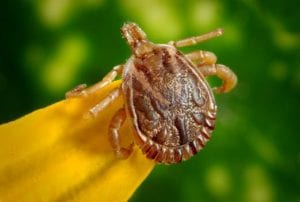Written by Joyce Smith, BS. This study demonstrated the effectiveness of a stevia extract to effectively eliminate all in-vitro morphological forms of Borrelia burgdorferi known to cause Lyme disease.
 Lyme disease, a tick-born multi-systemic disease caused by the spirochete Borrelia burgdorferi, infects 30,000/year 1. Antibiotic treatment is effective in up to 80% of cases and the remaining 20% of treated cases develop into antibiotic-resistant Chronic Lyme disease2. Resistance of these spirochetes (called “persisters”) can be attributed to a complex life stage with different defensive morphological forms, namely spirochetes, spheroplast or L-form, round bodies, and biofilms 3 that allows the organism to remain dormant and immobile in one of its morphological states until conditions, more favorable for its survival, entice it to revert to its spirochete form 3-6. The protective biofilm is a unique matrix of extracellular polymeric substances produced by B. burgdorferi that adheres to a surface within the host body while the spirochete conveniently adapts to its environmental conditions and becomes treatment-resistant.
Lyme disease, a tick-born multi-systemic disease caused by the spirochete Borrelia burgdorferi, infects 30,000/year 1. Antibiotic treatment is effective in up to 80% of cases and the remaining 20% of treated cases develop into antibiotic-resistant Chronic Lyme disease2. Resistance of these spirochetes (called “persisters”) can be attributed to a complex life stage with different defensive morphological forms, namely spirochetes, spheroplast or L-form, round bodies, and biofilms 3 that allows the organism to remain dormant and immobile in one of its morphological states until conditions, more favorable for its survival, entice it to revert to its spirochete form 3-6. The protective biofilm is a unique matrix of extracellular polymeric substances produced by B. burgdorferi that adheres to a surface within the host body while the spirochete conveniently adapts to its environmental conditions and becomes treatment-resistant.
Stevia rebaudian, proven in studies to be a safe natural sweetener and antimicrobial agent 7 was chosen by the authors to evaluate the antimicrobial potential of Stevia whole leaf extracts against the different morphological forms of B burgdorferi in vitro. Preliminary screening of four different extracts of stevia, found Stevia A (Nutramedix Stevia, a whole-leaf extract tincture in alcohol suspension) to be the most effective against Borrelia persisters.
Various quantitative techniques as well as different microscopy methods were used to compare the effectiveness of Stevia A (1.2ug/ml), and the antibiotics doxycycline, cefoperazone, daptomycin (10ug/ml) and their combination (identified in previous studies 8) against the different morphological forms of B. burgdorferi. Doxycycline (10ug/ml) became the positive control and the 25% alcohol dilatant used to dissolve the antibiotics became the negative control.
Compared to doxycycline (control) and the three-antibiotic combination, stevia A significantly eliminated the log phase spirochetes by approximately 94% and persisters by 84% (p≤0.01.) A 14-day subculture of stevia (done to test the regrowth potential of persisters), significantly reduced regrowth of borrelia compared to doxycycline (control). Stevia also significantly reduced borrelia biofilms grown on plastic and collagen surfaces by approximately 40% and 34% respectively compared to doxycycline (control) and the three-antibiotic combination (p≤0.01).
These results clearly demonstrate that stevia A was superior to doxycycline, cefoperazone, and daptomycin (all three are currently used to treat Lyme) in destroying B. burgdorferi in vitro. Stevia extract alone was able to eliminate the spirochetes and persisters as well as the most antibiotic-resistant biofilm form, while the individual antibiotics increased the biofilm rather than eliminating it. Additional investigation and clinical trials are required.
Source: Theophilus, Priyanka Annabel Sugantham, Maria J. Victoria, K. M. Socarras, Katherine R. Filush, Khusali Gupta, David F. Luecke, and Eva Sapi. “Effectiveness of Stevia rebaudiana whole leaf extract against the various morphological forms of Borrelia burgdorferi in vitro.” European Journal of Microbiology and Immunology 5, no. 4 (2015): 268-280.
© 2015 The Author(s)
Posted July 18, 2018.
Joyce Smith, BS, is a degreed laboratory technologist. She received her bachelor of arts with a major in Chemistry and a minor in Biology from the University of Saskatchewan and her internship through the University of Saskatchewan College of Medicine and the Royal University Hospital in Saskatoon, Saskatchewan. She currently resides in Bloomingdale, IL.
References:
- Centers for Disease Control and Prevention (PTLDS [Internet]. Lyme Dis website 2014 [cited 2015 Jun 8]; Available from: http://www.cdc.gov/lyme/postlds/index. html
- CDC. Lyme Disease. 2014; Lyme Disease website. Available at: http://www.cdc.gov/lyme/ststs/index.html Accessed June 9, 2015.
- Sapi E, Kaur N, Anyanwu S, et al. Evaluation of in-vitro antibiotic susceptibility of different morphological forms of Borrelia burgdorferi. Infection and drug resistance. 2011;4:97.
- Brorson Ø, Brorson S-H, Scythes J, MacAllister J, Wier A, Margulis L. Destruction of spirochete Borrelia burgdorferi round-body propagules (RBs) by the antibiotic tigecycline. Proceedings of the National Academy of Sciences. 2009:pnas. 0908236106.
- Sapi E, Bastian SL, Mpoy CM, et al. Characterization of biofilm formation by Borrelia burgdorferi in vitro. PloS one. 2012;7(10):e48277.
- Brorson Ø, Brorson S. In vitro conversion ofBorrelia burgdorferi to cystic forms in spinal fluid, and transformation to mobile spirochetes by incubation in BSK-H medium. Infection. 1998;26(3):144-150.
- Jayaraman S, Manoharan MS, Illanchezian S. In-vitro antimicrobial and antitumor activities of Stevia rebaudiana (Asteraceae) leaf extracts. Tropical Journal of Pharmaceutical Research. 2008;7(4):1143-1149.
- Feng J, Auwaerter PG, Zhang Y. Drug combinations against Borrelia burgdorferi persisters in vitro: eradication achieved by using daptomycin, cefoperazone and doxycycline. PLoS One. 2015;10(3):e0117207.
